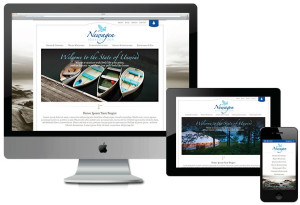 Sometimes we get too carried away about using the newest tool or distracted by some shiny new app. Sometimes we need to walk before we can run.
Sometimes we get too carried away about using the newest tool or distracted by some shiny new app. Sometimes we need to walk before we can run.Hell, sometimes we just have to crawl.
To that end, I wanted to put together a series of blog posts about what you really need to succeed online. What are the basics that you need to cover to increase your online visibility, drive more qualified traffic, and generate more leads and business?
Know the basics and want to skip ahead? Download Website Basics 201 for free now!
Download Website Basics 2.0 Now!
With this post, we’ll focus on the hub of you digital marketing: your website.
The Absolute Basics
Yes, we’re starting slow. Use the headers to skip ahead.
Get a domain name.
If you don’t have one, that is. Every website needs an address where people can visit.
Dot coms are preferable over any other top level domain (TLD) such as .net, .org, or .biz. Avoid hyphens if you can, and never use more than one. Multiple hyphens may have a negative impact on your search rankings and tend to look spammy.
Make sure you own your own domain name and have full control over it. It’s best if you register your domain yourself rather than having someone else, like a web designer, do it for you.
Use an established registrar like GoDaddy or Network Solutions, rather than an unknown company. Cheaper options offer poor support, something you’ll need if you want to make a change to contact information or are changing hosting companies.
Choose a web designer/developer.
You actually don’t need a web designer. There are services out there like Wix or SquareSpace that allow anyone to build a site. If you have no interest in using your website to generate business, this may be a good solution for you.
That’s not me being facetious. For some businesses, a website is nothing more than an online brochure to prove you exist; it’s not meant to generate any business. It’s an expense, not an investment.
However, if you need to generate leads and sales from your site, hiring a web designer is one of the best decisions you can make. Like any service professional, they can offer help and guidance to create a website that will grow your business.
Some web designers are just that: designers. They can make a pretty site, but it may not do much else. Other designers work with a team of developers and marketers that may be better positioned to help you succeed. Choose based on what you hope to accomplish, as well as their track record.
Get hosting.
Hosting is another place where people try and save money. Cheap (or even free) hosting is great…until you run into a problem. Which you will. Then you won’t be able to get anyone on the phone, your site will be down, your email won’t work, you won’t make any sales, they’ll repossess your car and you’ll have to take the bus.
Happens every time.
Very often your web developer will recommend hosting for you, or may offer hosting herself. Often it’s best to go with her recommendation because she's familiar with the hosting arrangement and will know which hosting package is right for your business.
If you plan on taking credit cards, you’ll need PCI compliant hosting. Not every host offers this, so you’ll need to look around unless your web developer can hook you up.
Build on a content management system (CMS).
A content management system, or CMS, allows you to update your website through any browser. Add a page, upload a photo, update your event calendar, embed a video from your YouTube channel, even update the navigation…you get the picture.
While there are plenty of great CMS’s available, I strongly recommend WordPress for small businesses (and non-profits!) The software itself is free, and it’s open-source. That means that if your web developer falls into a hole and Lassie can’t save him, there are only like a gazillion other WordPress developers who can jump in and help out.
I’ve known many small businesses that wanted a divorce from their web developer, but because they were on that developer’s proprietary system, they couldn’t leave. Don’t let that happen to you!
Make it mobile friendly.
 There’s no excuse these days to have a non-mobile-friendly website. More than half of the world’s Internet traffic is delivered onto a mobile device. If your website requires people to pinch, zoom, and otherwise treat it like a ball of dough to use it, it’s not mobile friendly.
There’s no excuse these days to have a non-mobile-friendly website. More than half of the world’s Internet traffic is delivered onto a mobile device. If your website requires people to pinch, zoom, and otherwise treat it like a ball of dough to use it, it’s not mobile friendly.There are several ways to make your site mobile friendly, but probably the best one for most businesses today is called Responsive Web Design. Responsive sites optimize themselves to fit into any size screen, from desktop to tablet, laptop to smartphone. Not sure how they’ll work on the Apple Watch yet.
There are many options in WordPress for responsive designs, and even if you’re not on WordPress, your web developer should be able to design a responsive site, or at least a mobile-friendly one.
Make it about your customers.
Most businesses mistakenly think that their website is about their business. Nothing could be further from the truth.
Your website is about your customers. Its purpose is to serve them.
People arrive at your site listening to radio station WII-FM. What’s In It For Me. (In the age of Sirius XM, Spotify, and Internet radio, that line is showing its age.) They care more about their problems then your solutions. If you start in talking about how long you’ve been in business, or how you have some of the best products on the market, or your people are better trained then your competitions, they’ve already hit the back button.
Optimize your copy for search engines and people.
I plan on talking about SEO (Search Engine Optimization) in another Back to Basics article in more depth. However, it’s important to write copy on your site that will rank well at the search engines and persuade people to take a desired action at your website.
Each page on your site should narrowly focus on a subject related to your business. It could be a product, service, or benefit your business offers. Using a tool like Keyword Planner, you can do some research on how often a desired keyword is searched on each month. Are your customers searching on “hair loss” or “hair replacement?” Not using the words your customers use can prevent them from ever finding your website.
I’m going to make a strong pitch here for hiring a professional copywriter. A good copywriter will write compelling copy that ranks well at the search engines. They’ll get it done on time and on budget. They’ll free up your time so you can concentrate on running your business.
Writing your own copy isn’t a way to save money, it’s a way to lose time, energy, and sales.
Don’t scrimp on photography.
 Put away your iPhone and step away from that royalty-free photo of two hands shaking. Nothing can destroy a well-designed website faster than cheap stock photography or poorly lit staff photos.
Put away your iPhone and step away from that royalty-free photo of two hands shaking. Nothing can destroy a well-designed website faster than cheap stock photography or poorly lit staff photos. We are visual creatures and we have the attention span of a tsetse fly. If your images don’t immediately grab your site visitor, or come off making you look cheap or generic, he'll quickly lose interest and move on to your competitors’ sites.
There’s good stock photography out there, but you’ll rarely find it at a discount site. You can also differentiate yourself from your competition by hiring a professional photographer. Prices range based on your location, but you can use those photos at your website, social media channels, email newsletter, and print material.
Get visitors to take action!
Your website should be generating leads and sales for your company. To that end, you have to ask for the business.
Every page on your site should end with a call-to-action, and possibly include a few along the way. You should give people guidance on what the next step is with a link or button, such as “Contact us today for a free consultation,” or “download your guide for saving money on college,” or “Buy now!
Build your list.
One of the most valuable resources your company owns is its list. And in this day and age it’s an opt-in email list. By opting in, visitors have given you permission to market to them—and access to their inbox–quite possibly the most valuable real estate on the web.
Like SEO, I plan on putting together a more in depth Back to Basics post on list building and email marketing.
For the purpose of your website you should offer a lead magnet to incentivize visitors to leave their email address. A free download, discounts in your online store, whatever they would find valuable.
Make it easy to contact you.
We’ve all been there. We want to contact a company, possibly place an order, but we can’t find their contact information on their site.
Argh!!
If you want the phone to ring, put your phone number at the top of every single page on your site. And make sure that it’s actual text, rather than a picture of your phone number. That way, if people are accessing your site on a smartphone they can simply click the phone number to call you.
Make “Contact Us” part of your navigation bar. Have a contact form on your contact page. Don’t include your email address on your site unless you want to get a bunch of spam about Russian wives, low mortgage rates, and Canadian pharmacies.
Also, don’t use CAPTCHA (those funky letters people have to type in to submit a form.) They just frustrate your prospects. Instead, try GravityForms if you’re on WordPress or Wufoo if you’re not.
Measure your traffic.
It’s important to know how much traffic your site is getting, where your visitors are coming from, and what their behavior is once they get there.
For most small business, Google Analytics is the way to go. It’s free and insanely powerful. Your web developer should be able to quickly add the snippet of code to every page so you can start measuring your results.
Keep your website healthy.
 Set up a free account with Search Console (formerly Google Webmaster Tools) and connect it to your Google Analytics. Not only will this unlock more reports in Google Analytics, it will provide you critical information about any problems your site may be experiencing.
Set up a free account with Search Console (formerly Google Webmaster Tools) and connect it to your Google Analytics. Not only will this unlock more reports in Google Analytics, it will provide you critical information about any problems your site may be experiencing.Try and get in the habit of checking your Google Analytics and Google Webmaster Tools weekly.
What’s next?
Your website will always be the hub of your online activity. Sites like Facebook and Twitter may come and go, so you should use these platforms to drive people back to your site and get them to opt in to your email list, fill out your contact form, or give you a call.
Add a blog and update it regularly. Or at least consistently. Send blog posts to your email list using a service like Constant Contact (aff).
Once your website is up and running, regularly check your analytics and webmaster tools. Make changes to your site based on the results you see. By keeping up this positive cycle, you’ll raise your online visibility, attract more prospects, and generate more leads at your site.
What do YOU think?
I'd love to know what you think. Did I get it all? Is there something you think is critical that I left off? Let me know in the comments below. Thanks so much!
